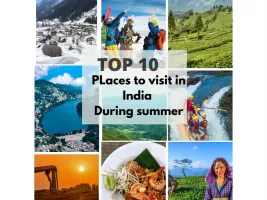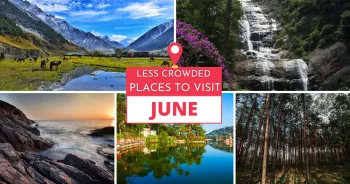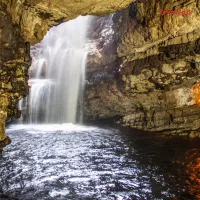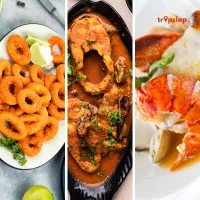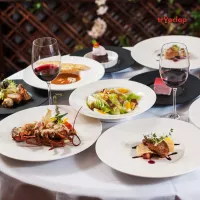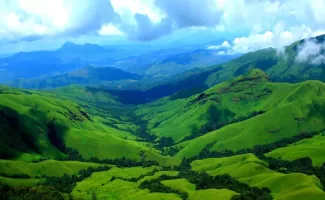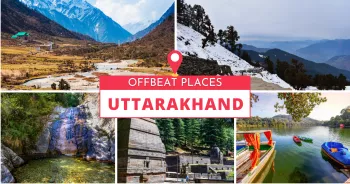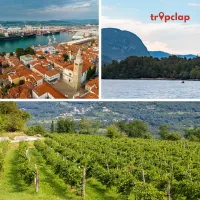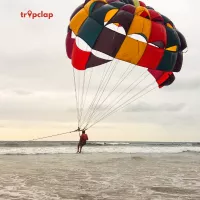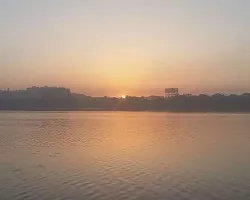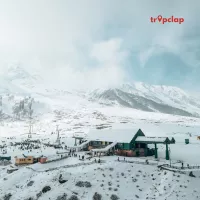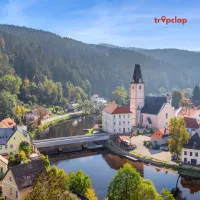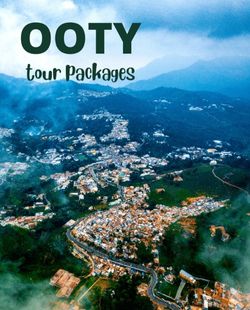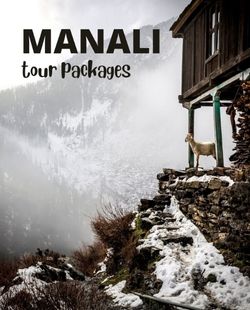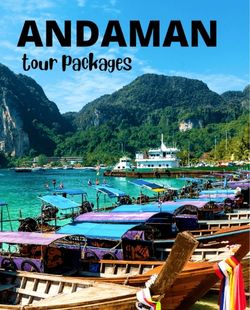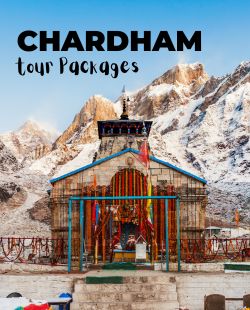Barriers and Facilitators of managing Small Hotels in Hospitality
- Tripclap
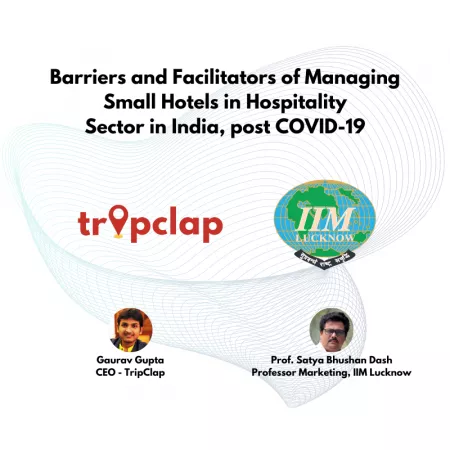
Table of Content
- CERTIFICATE OF APPROVAL
- ANTI-PLAGIARISM DECLARATION
- ACKNOWLEDGMENT
- ABSTRACT
- INTRODUCTION
- RESEARCH OBJECTIVE
- LITERATURE REVIEW
- Challenges faced by small hotels
- QUALITATIVE STUDY INPUT (13 Depth Interviews)
- HYPOTHESIS GENERATION FROM QUALITATIVE SCHEDULE AND LITERATURE REVIEW
- METHODOLOGY
- TARGET GROUP
- SAMPLING
- SAMPLING PROCEDURE
- RESEARCH OBJECTIVES, DATAANALYSIS, AND RESULTS
- CONCLUSION
- References
CERTIFICATE OF APPROVAL
This is to certify that the dissertation entitled “Study the barriers and facilitators of managing small hotels in the hospitality sector in India, post COVID 19” submitted by Gaurav Gupta is an original work and has not been submitted earlier either to Indian Institute of Management Lucknow or any other Institutions. We do not approve any statement made, opinion expressed and conclusion drawn therein but approve the dissertation only for the purpose for which it is submitted. Further, the candidate has submitted a signed Anti-Plagiarism Declaration for which s/he is solely responsible and accountable. Signature of the Dissertation Advisor Prof. Satya Bhushan Dash
ANTI-PLAGIARISM DECLARATION
I understand that:
1. Plagiarism is to present someone else’s ideas as my own.
2. I know that I would plagiarize if I do not give credit to my sources, or if I copy sentences or paragraphs from a book, magazine, journal article, the Internet, or any other source without proper citation.
3. I know that even if I only change the wording slightly, I still plagiarize when using someone else’s words without proper citation. 4. I know that plagiarism is wrong and a serious offense.
I declare that this dissertation entitled, “Study the barriers and facilitators of managing small hotels in hospitality sector in India, post COVID 19” submitted to the Indian Institute of Management Lucknow in partial fulfillment of the requirements of the Post Graduate Programme in Management for Working Executives is my own original and authentic work. I have written my own sentences and paragraphs throughout this work and have credited all ideas gained from other people’s work or secondary sources. Where material written by other people has been used (either from a printed source or from the Internet), it has been carefully acknowledged and referenced through citation and reference.
I declare that no unethical research practices were used or material gained through dishonesty. Further, I have not allowed, and will not allow, anyone to copy my work with the intention of passing it off as his or her own work.

ACKNOWLEDGMENT
The completion of this research would not have been possible without the support and contributions of many individuals and organizations.
I would like to extend my sincere gratitude to: My advisor, Prof. Satya Bhushan Dash, for his unwavering support, guidance, and encouragement throughout the research process.
His expertise and insight have been invaluable to me. IIM Lucknow, for providing the resources necessary for the successful completion of this research.
Marketing Department, for their support and for providing a supportive and stimulating environment in which to conduct my research. Dr. Himanshu Talwar (Executive Director, TAAI), Jaison Chacko (Secretary General, FHRAI), for their helpful suggestions, critical feedback, and contributions to the development of this research.
The participants of this study, who generously shared their time and insights, enabling me to gather the data needed to complete this research. I would also like to acknowledge the countless hours spent in the library, reading and researching, as well as the late nights and early mornings spent writing and revising.
Finally, I would like to express my deep gratitude to my family, friends, and loved ones for their unwavering support and encouragement throughout this journey. This research would not have been possible without them. Thank you all for your support, and I hope that this research will contribute to the advancement of knowledge in studying the barriers and facilitators of managing small hotels in the hospitality industry post COVID 19.

ABSTRACT
Much research has happened in the hotel industry across the globe and even in India. However, only a few studies focus on the problems of small and medium-sized hotels, which are not chains of hotels but family-oriented businesses based out of the metro, hill station, and non-metro cities. In India, ‘The Sarai Act of 1867’ is still applicable, and the classification method is still the same, created under the leadership of M.S Oberoi in 1956 with some incremental changes. Post, Covid-19 lot of small and medium-sized hotels were crying foul on the viability of their business due to the absence of a relief package from the government of India.
Therefore, this study is done to understand the barriers and facilitators of small and medium-sized hotels in India, especially after COVID-19. In this study, qualitative and quantitative research methods were used to understand the grievances of hotels. In total, 13 Depth Interviews were conducted, and then the quantitative questionnaire was prepared after analyzing the qualitative input & the hypothesis which were generated. The target groups were the owners/managers of hotels. The sample size has been kept very diverse and has collected responses from all major parts of our country.
After analyzing the data, I accepted and rejected some hypotheses and ultimately found that the business is back to the same as before COVID-19. No significant changes have happened in the activities of the hotel. There are a lot of barriers/challenges to managing these hotels; however, the major ones are lack of quality/trained staff, absence of digital marketing staff, and last but not least, needing their website. This is why most hotel owners have voted ‘having their own website’ as the most significant facilitator for their hotel. A website gets them direct bookings, and they do not have to share revenue. When the world talks about Web 3.0, 40% of hoteliers do not have a website. It is important to note that having a hotel classification helps, and as per the statistics, hotels that take classification rated their challenges on the lower side. The hotel industry focussed more on long-term growth than short-term gains, which is why they invested much time in branding their hotel. This gives all the more reasons for the authorities to increase the set-off period of business losses for this capital-intensive hotel industry
INTRODUCTION
The travel and tourism business contributed $121.9 billion to the Indian gross domestic product in 2020. It contributed $191,3 billion to the GDP in 2019.
According to the "Hotel Industry in India (2018-2023) Industry Overview" the hotel industry in India is expected to grow at a compound annual growth rate (CAGR) of 13% between 2018 and 2023, resulting in a value of INR 1,210.87 Bn by the end of 2023. This growth is attributed to the influx of international tourists and business delegates.
The Tourism and Hospitality Industry report states that the Indian hotel market, which includes domestic, inbound, and outbound segments, was valued at US$ 32 billion in FY20 and is anticipated to grow to US$ 52 billion by FY27. This growth is attributed to the rise in demand from passengers and the continuous efforts of travel agencies to expand the sector, positioning it as one of the top hospitality industries in India.
Under the government of India’s NIDHI 2.0 (National Integrated Database of Hospitality Industry) scheme, a database of different types of accommodation units in the hospitality sector, travel agents, tour operators, & others will be maintained. NIDHI 2.0 will facilitate the digitalization of the hospitality sector by encouraging all hotels to register themselves on the platform. Till now, more than 38000 hotels have registered themselves under different categories. Out of which more than 20000 are hotels and more than 5000 are bed and breakfast. (Nidhi 2.0, n.d.)
The hospitality sector of India has been highly competitive. However, due to COVID-19, it has to take up huge losses (Kumar, 2020, #), due to which many small hoteliers had to close down or reduce their rooms to remain viable in their respective segments. Small hotels can be segmented under various names per classification under the NIDHI scheme (Nidhi 2.0, n.d.) as they are not chain hotels and have an annual turnover of fewer than ten crores or less than 50 rooms.
Therefore, CEOs of modest, traditional hotels should have an understanding of revenue-boosting marketing tactics. Prior research has examined the performance of hotel operations ((Parkan, 1996, #, Sainagh, 2010, #), distribution channels for the hotel industry ((Choi & Kimes, 2002, #, O'Connor & Murphy, 2008, #), crisis management in the hotel industry (Zech, 2016), (Wai Lai, 2020, #), and service quality in the tourism industry (Kuo et al., 2012; Lai, 2014).
However, (Majumdar, 2021, #) stated that the pandemic has had a greater financial impact on hotels at the lower end of the market segment than on high end service providers. No empirical or theoretical studies have been conducted that recommend the obstacles and facilitators for small hoteliers to survive in the post-Covid-19 era. Therefore, a study in this field would be extremely advantageous.
RESEARCH OBJECTIVE
The research objective of this study is to understand the barriers and facilitators of managing small hotels in the hospitality sector in India post-COVID-19 era. Study aims to
1. RO1: Explore the activities of small hotels in terms of their business operations, aspirations, market needs.
2. RO2: Understand the major challenges encountered by small hotels to continue their operations before and post Covid-19 crisis.
3. RO3: Identify the major facilitators of small hotels growth.
4. RO4: Explore recommendations for the small hotels to manage their business.
LITERATURE REVIEW
Classification of Hotels in India
Professional hotel industry in India was founded by British citizens during the 1800s. However real large scale hotels were started in India in the 1900s when Jamshedji Tata took over Clarkes Hotel in 1902. The mechanism of classification of hotels in India started in 1956 under the leadership of M.S. Oberoi establishing following goals (Seth 2006)
a. To lay down criteria of classification, keeping in view international standards, for every hotel in India
b. To provide strategies for promoting tourism in India
c. To suggest improvements in existing arrangements
A committee was formed in 1955 which decided to accept a star rating system to classify Indian hotels (Sinha 2021). These guidelines were renewed in 2003 and 2013 by the Ministry of Tourism but were more towards meeting international standards by Indian hotels. These factors include location information, ownership status, site information, project information (size, area, facilities, energy conservation, etc.), blueprints for all areas, the intended financial structure, and efforts for talent development (running training courses). The second section of the standards addresses the degree of services the hotel must provide. These amenities are further subdivided into guest room facilities, bathroom facilities, public area facilities, disability facilities, food and beverage facilities, kitchen facilities, guest services, safety and security, communication facilities, and environmentally friendly practices. In doing so, the major focus was always on top end hotels rather than on small hotels. There is also not very clear demarcation between small, medium and large hotels. Only 1880 hotels (Appendix A) have taken star classification in India, of which majority is 3 star hotels i.e 564. However more than 40,000 hotels have listed themselves on Nidhi 2.0 portal. This shows that hotels are not taking star classification because 1 of various reasons. Mr.Jaison Chako (Chief Secretary of FHRAI) says there would be estimated more than 80,000 hotels in India and many of them are in oblivion and are looking for the right platform for generating more sales. This huge number shows that it is difficult to classify every hotel in a star category bucket, therefore Nidhi 2.0 has defined different type of hotels which 2 includes hotel, Resort, Bed & Breakfast, Timeshare Resort, Apartment Hotel, Guest House, Farm Stay, Lodge & Tourist Home, Houseboat, Heritage, Motel, Legacy Vintage. Having all this done, there is still a segment in the hotel industry which is facing challenges of survival. Though they don’t fit in any of the above categories I have tried to identify them, post discussing some stalwarts of the hotel industry including Mr. Jaison Chako, Dr. Himanshu Talwar; based on the number of rooms they have. Because the number of rooms a hotel has tells a lot of story behind his operations.
As per my research findings there haven't been much studies done on small and medium hotels present in India. The reason is it’s difficult to classify this cohort. Although government of India has a classification mechanism of SME based on annual turnover however there isn’t any such 3 classification of hotels. Some findings which happened on small hotels are done in Croatia (Vrkljan, Sanela. (2022)), Malaysia (Wei Boon Quah and Jennifer Kim Lian Chan, PhD (2008)). Small Indian hotels are underrepresented in the Indian economy as there is no direct mechanism of knowing their contribution. Lot of time studies are conducted around 5 star(Gupta, V. and Sahu, G. (2021)), 4 star(Hahang, E., Bayraktar, S. and Jiménez, A. (2022)) hotels and the challenges of small hotels remain unknown. Efforts of small hotels get cumulatively added in the SME Service sector of India and don't get the right recognition. Through my study I want to understand the barriers and facilitators for small hotels in India. Here are some of the findings from some famous works done on hotel industry around my research objectives:

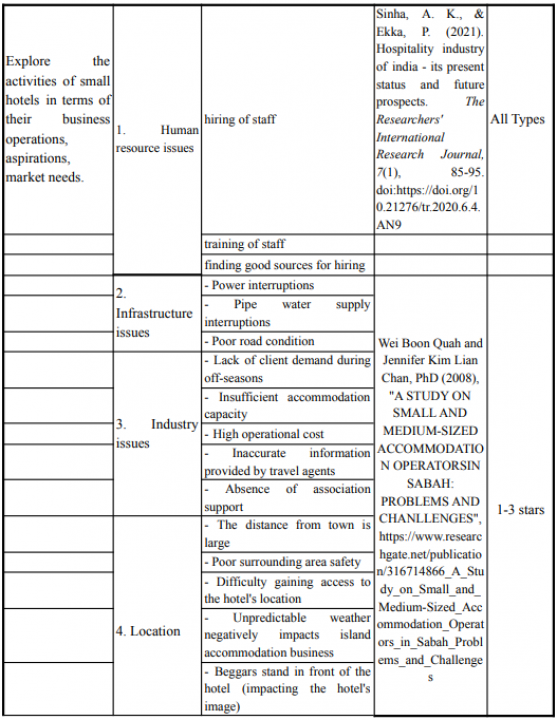
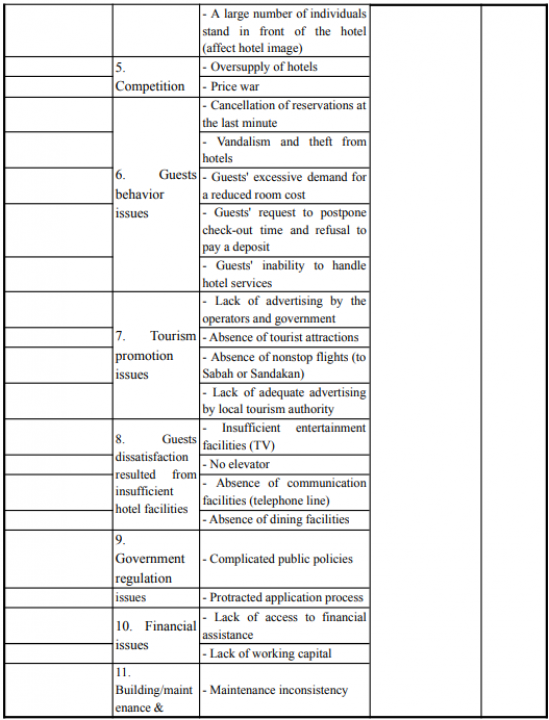
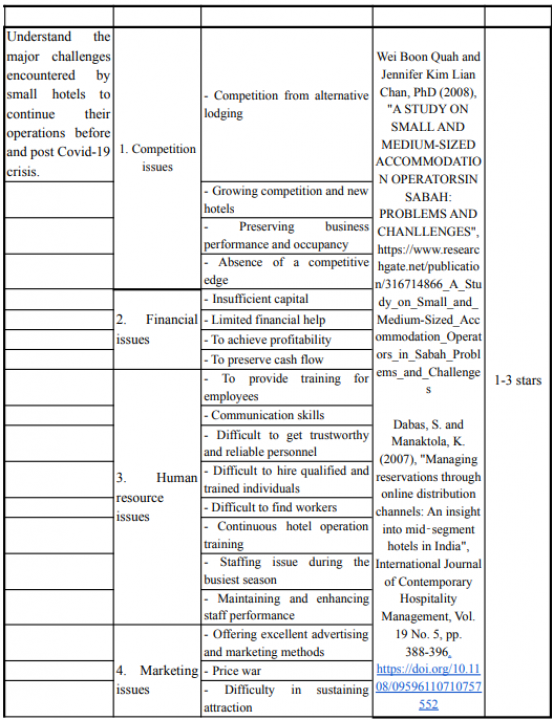
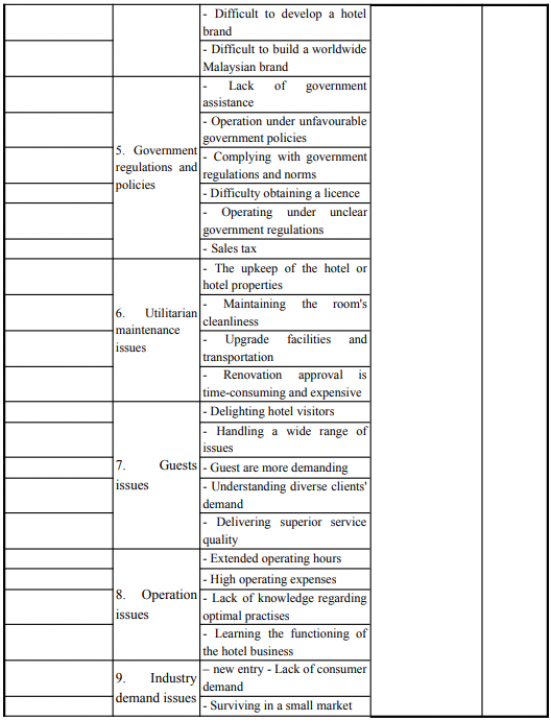
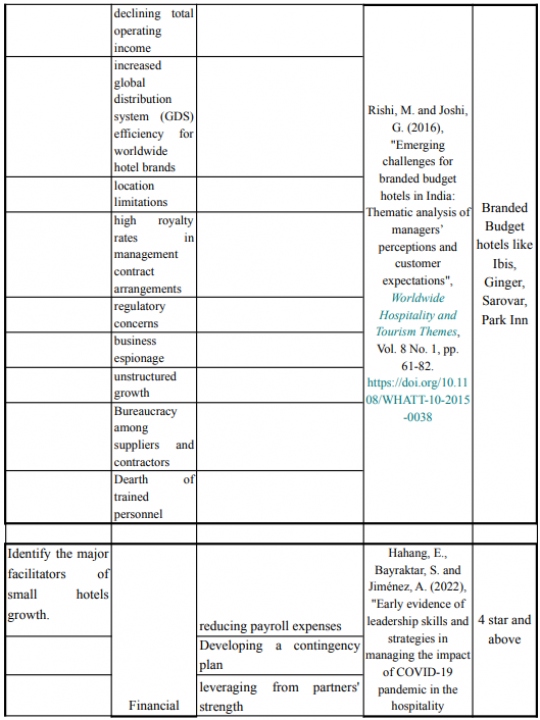
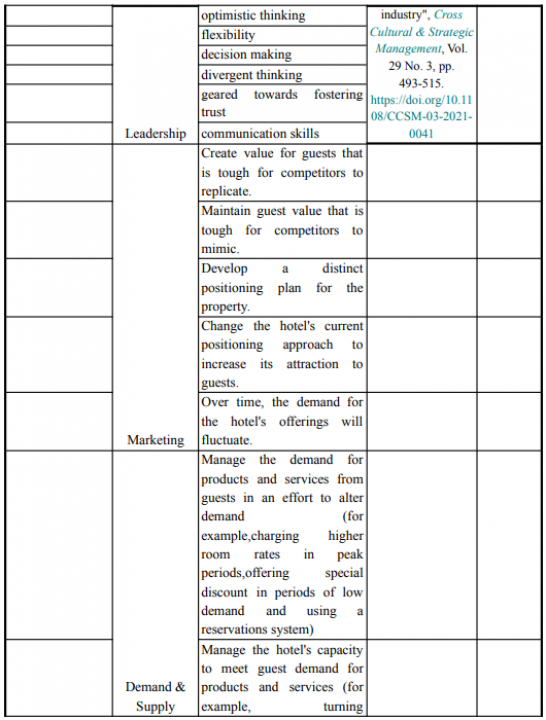
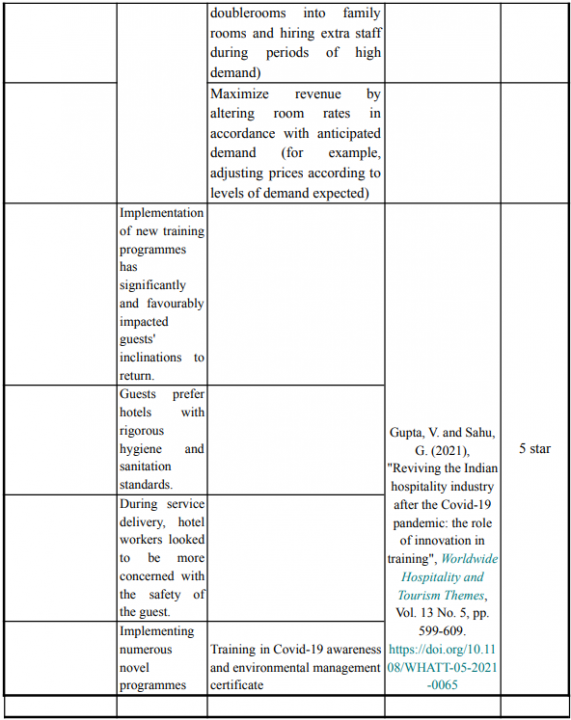
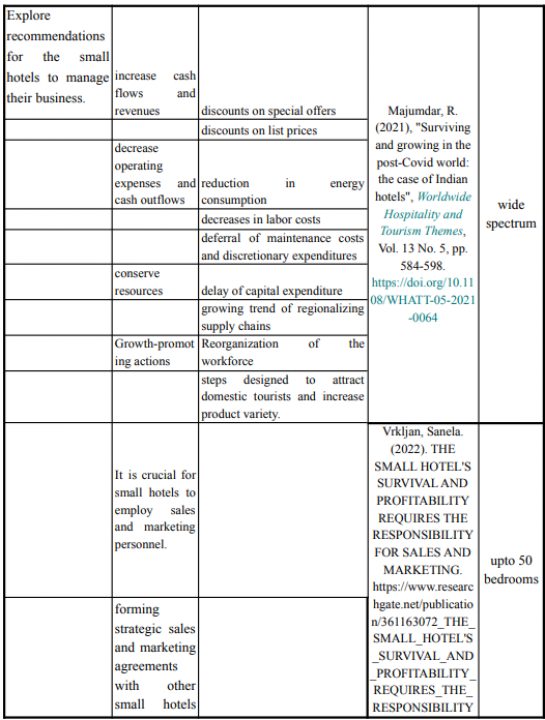
Challenges faced by small hotels
The hotel sector confronts numerous problems, and a negative visitor experience can deter them from selecting a specific brand. Nain (2018) used secondary data from the United Nations World Tourism Organization (UNWTO) to investigate the hospitality industry's main worldwide difficulties. The primary issues noted by the researcher include economic influx, labor shortage, and employee retention. In addition, the increasing technology demand, maintenance of hygiene standards, and delivery of a genuine and exceptional human experience make hospitality a problematic industry. In addition, hotels suffer an increase in subsite rivalry, a need for more modern marketing techniques, and security concerns, among other problems. For example, the restaurant industry in the United States employs almost 14 million people, yet the talent pool is nearly drained (Nain, 2018). To maintain a positive brand image, hotels must engage qualified personnel. The researcher observed that some clients' service requirements had migrated toward current technology. This trend started with the demand for complimentary Wi-Fi; however, clients increasingly desire an atmosphere with robots, voice control, innovative bars, and sports simulators (Nain, 2018). To flourish in the sector, hotels must strive to meet or surpass guests' expectations during their stay.
The hotel industry has opportunities for multinational corporations and wealthy nations. Jackson (2017) and Kumar (2017) studied similar issues in Malawi and India. In an analysis of 194 hotel facilities in Malawi, the researcher found that the industry confronts challenges in building management, physical infrastructure, new technologies, and marketing. Respondents in the survey also complained about inadequate policies, insufficient government support, and exorbitant lending rates. In contrast, the Indian hotel business has a distinct set of challenges. The study identified the inaccessibility of hotels, lack of basic amenities such as water, poor infrastructure, expensive amusement tax, insufficient government support, and natural disasters as key obstacles (Kumar, 2017). Another Indian-based study highlighted economic concerns, global uncertainties, labor, financial feasibility, security, operating cost, and shifting consumer preferences as the most significant obstacles to the hotel industry's expansion (Hole, Khedkar & Pawar, 2019). Thus, the industry faces numerous issues, some of which are global while others are organization- or region-specific. Most challenges impeding the industry's development are amenable to multi-stakeholder methods, such as government collaborations, among other variables. Numerous scholars have focused on this problem because of its considerable significance.
QUALITATIVE STUDY INPUT (13 Depth Interviews)
https://docs.google.com/spreadsheets/d/1uytG4bKTFgfDaKDovR9h9iaX6z9SJ842/edit?usp=sha ring&ouid=100944927524309299067&rtpof=true&sd=true )
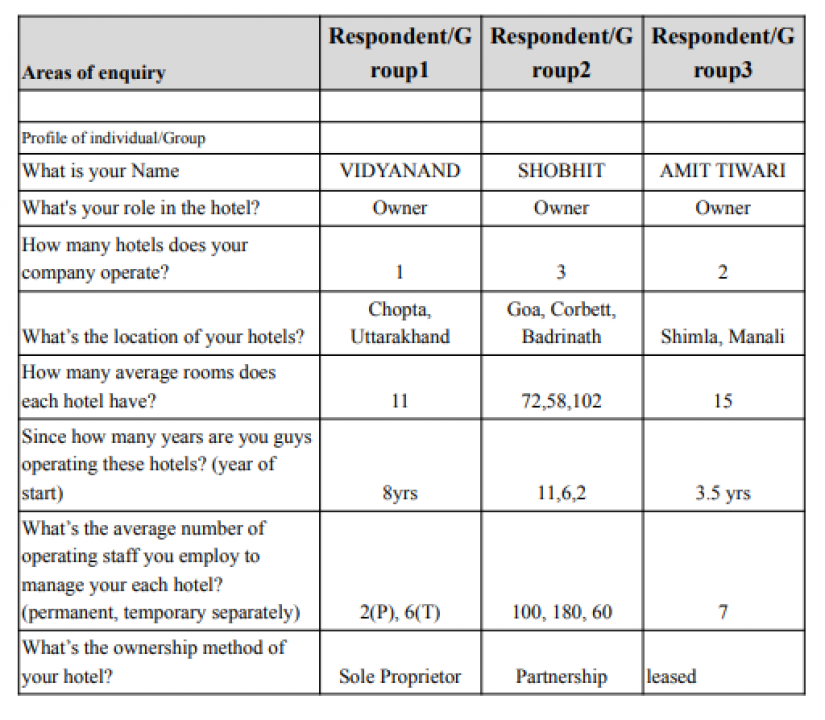
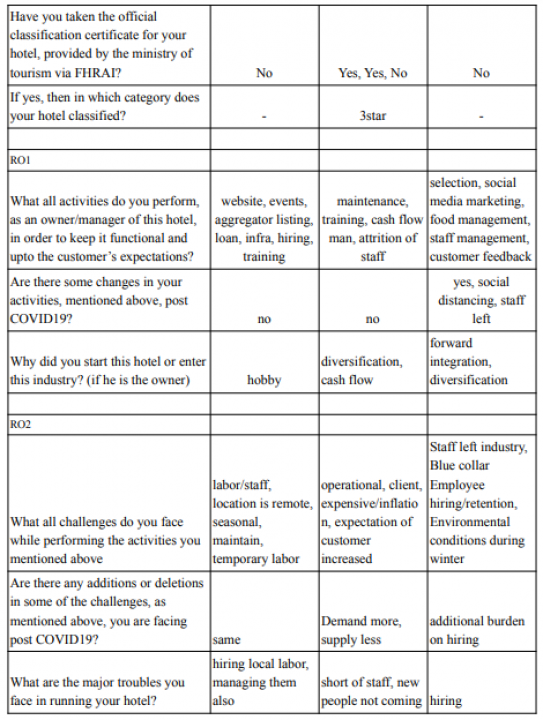
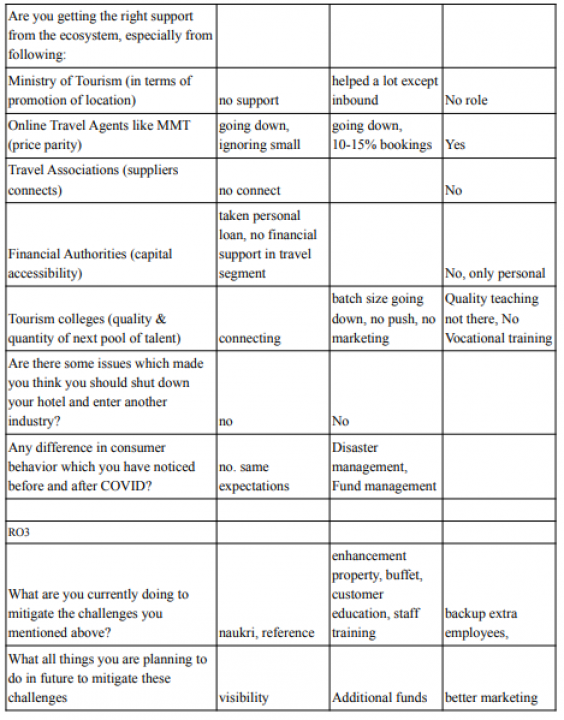
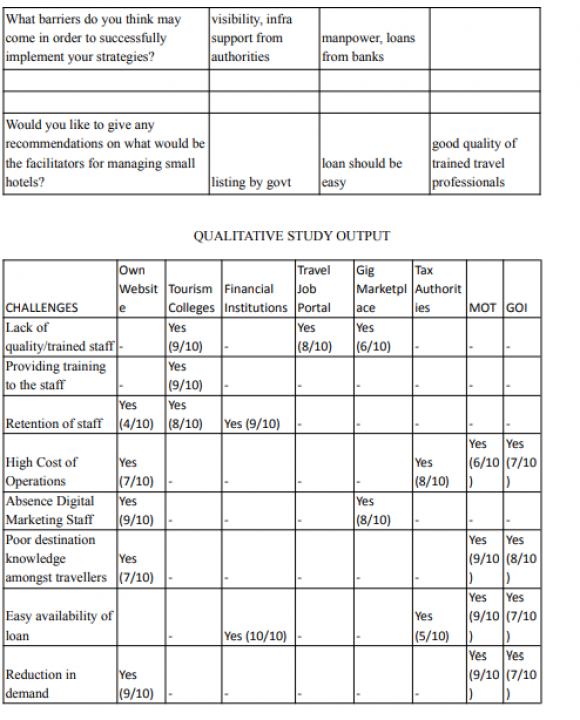

HYPOTHESIS GENERATION FROM QUALITATIVE SCHEDULE AND LITERATURE REVIEW
Research Objective
1: Explore the activities of small hotels in terms of their business operations, aspirations, market needs. Hypothesis 1: Hotels in hilly areas devote majority time in hiring skilled staff Vidyanand ji from Chopta said that ‘hiring is the major trouble which I face in managing my hotel’ JP Rana from Kedarnath said ‘Achcha yuva hill station kaam karna ke liye nahi aana chahta. Wo kewal ghoomne aana chahta hai.’ Also hoteliers from Kashmir, Manali, and Darjeeling said the same thing.
Hypothesis 2: Hotels in Metro devote average time in doing digital marketing for generating bookings Mr. Qabool Dugal who has a hotel in Delhi said ‘Ham average time devote karte hain digital marketing main. Na zyada na kam (we devote average time in doing digital marketing. No more no less) Mr Ajay Sundaram from Chennai said ‘digital marketing is important for generating sales however we have other works also. So give average time to digital marketing’
Hypothesis 3: More than 80% hoteliers are saying there is no change in their activities post covid 19 10 out of 13 hotels, irrespective of their location, said there is no change in their activities post COVID-19
Research Objective 2: Understand the major challenges encountered by small hotels to continue their operations before and post Covid-19 crisis.
Hypothesis 1: Hiring Quality/trained staff in hilly areas is more challenging than hotels in metros 6 out 7 hotels in hill stations (Shimla, Manali, Kedarnath, Shillong, Darjeeling, Kashmir) mentioned hiring in their challenge however hotels in metro ie Mr. Qabool, Mr. Ajay didn’t mention hiring in their challenges. Mr Amit Tiwari from Shimla said ‘Quality staff industry ko chod chuka hai, and Shimla main jahaan baraf girti hai and inaccessible ho jata hai sardiyon main - hiring ek bahot bada challenge ban jata hai. Log milte nahi hain and aana bhi nahi chahte’
Hypothesis 2: Those who take classification faces less challenges Gupta, V. and Sahu, G. (2021), has recommended all the practices which are present in the classification norms by the ministry of tourism to be followed by Indian hotels, which makes a hotel more successful. This means there are less hurdles for the hotels which follow the classification norms.
Hypothesis 3: Star rating influences the rating of a challenge given by a hotel Mr. Vidyanan, Mr. Amit Tiwari, Mr. JP Rana who have not taken hotel classification mentioned 5,5,6 challenges each; however Mr. Shobhit and Mr. Qabool who have taken hotel classification mentioned only 3 challenges for their hotels Research Objective 3: Identify the major facilitators of small hotels growth.
Hypothesis 1: Tourism colleges are rated lowest by hotels in metro compared to other hotels None of the hotels in metro areas i.e Mr. Qabool, Mr. Ajay, Mr. Joginder Pal from Delhi, Chennai, Chandigarh discussed tourism colleges as their facilitator to manage their business. However, Mr. Amit, Mr. JP Rana, Mr. Vidyanand, Mr. Luv said tourism colleges, a source of quality staff, are a facilitator for managing their hotel business.
Hypothesis 2: For bigger hotels (30+ rooms) Tax authorities are the main facilitators Mr. JP Rana, Mr. Luv Thakur from hill stations having more than 30 rooms and Mr. Qabool, Mr. Ajay from Metro areas having more than 30 rooms mentioned that tax authorities as their facilitators as variable taxes is a major trouble for managing a hotel business. Hotel owners do not want to waste their energies in that and believe that tax authorities are one of their biggest facilitators by having a simple regime for the same. Mr. Jaison Chacko from FHRAI also said - ‘Taxes in the hospitality industry in India are the highest in the world. This leads to lower occupancy of hotels. Flat GST @ 12% will be a good facilitator’
Research Objective 4: Explore recommendations for the small hotels to manage their business.
Hypothesis 1: Hotels in hill stations need easy availability of loan Mr. Saqib from Kashmir said ‘yahaan hotel ke naam par loan milna bahot mushkil hai’ and Mr. Luv Thakur from Manali said ‘there should be enough NBFC, Bank branches to get us loans on behalf of our hotel’. Mr. JP Rana, Mr. Amit Tiwari also iterated the same thing. As being in hilly areas, the presence of financial authorities is poor and doing viability analysis for providing loans becomes all the more tough.
Hypothesis 2: Bigger hotels, having more than 30 rooms, in metro wants uniformity in GST the most As mentioned above, Mr. Jaison Chacko, Chief Secretary of FHRAI has mentioned the need for a uniform GST. This is also reiterated by Mr. Joginder Pal, Financial head of a hotel in Chandigarh. He said ‘hamara kaam badh jata hai due to differential taxes on rooms, F&B, Uniform GST regime will be very helpful’.
Hypothesis 3: Size & location of hotel impacts the recommendations It is observed from the qualitative input sheet recommendations that vary depending upon location and size. For example bigger hotels are talking more about loans, GST etc and hotels in hill stations are talking about hiring issues.
Therefore, I believe that there should be some connections of recommendations depending on the size and location and it needs to be validated.
METHODOLOGY
Phase 1: Exploratory study aimed to capture the viewpoints of small hotels in the hospitality sector. I first conducted two open ended DI (depth interviews) with a sample cluster. These interviews were conducted in Hindi, English and were recorded in audio and video format. Post interviews I tried to draw some commonality and come up with a right schedule. In-depth interview (DI) enabled us to understand hotel’s experience, operational challenges, strategies used to mitigate these challenges, and the support systems needed to revive in the post-pandemic scenario. DI were helpful in obtaining individual perception, industry specific (hotels) marketing and operational capabilities and technological maturity to address Covid-19 like collective health crisis in future.
Phase 2: Quantitative study will be conducted via survey form which will have a structured format of questionnaire. It will be emailed to respondents to collect approximately 100 responses which shall help us identify principle barriers and facilitators for managing small and medium hotels in the hospitality sector, post COVID-19 era.
TARGET GROUP
Profile: Owners & Managers of a small hotel Rationale: Top management of a hotel have a clear understanding of all operations that take place.
Rooms/Hotel: upto 50 Rooms (appendix A) Rationale: Majority small hotels don’t take classification certificates from MOT. 5
Therefore it is an indirect mechanism of categorizing small hotels based on data from the annual report of 2021 by the ministry of tourism. Found out rooms/hotel of 1*,2*,3*, Guest House, Bed & Breakfast.
Hotel Types: 1* Hotel, 2* Hotel, 3* Hotel, Lodge, Camps, Bed & Breakfast ( Nidhi 2.0, 6 n.d.) S
SAMPLING
We will divide our sample into two sub segments and the regions of India where their hotel is located.
They should fulfill above criteria and
a. Leisure markets : are those which have a large number of domestic tourist arrivals due to tourist locations.
b. Metros : are the major metro cities where people come for work and need night stays.
Sample size for Qualitative study: 13 DI (Depth Interviews) : 13 Sample size for Quantitative study: 184
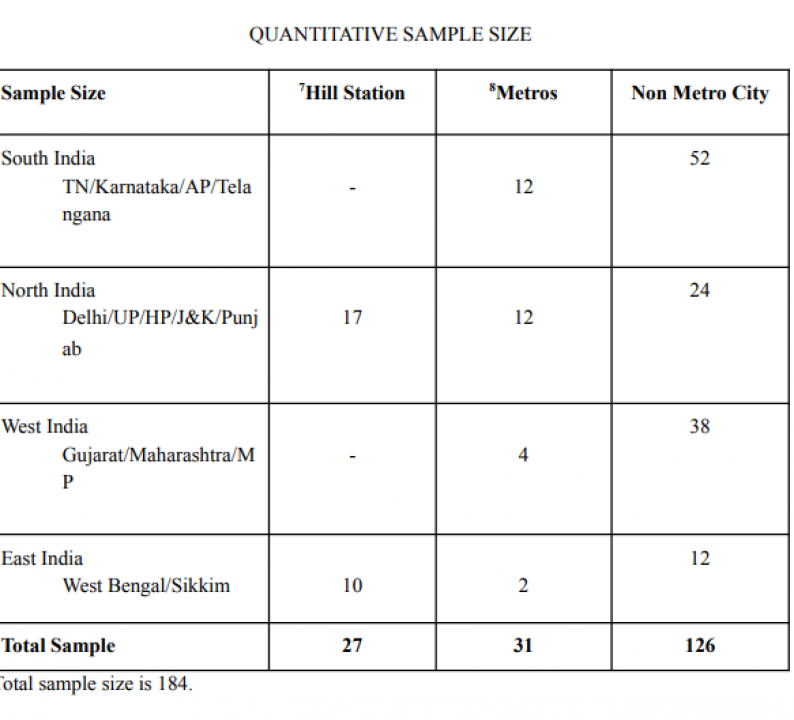
SAMPLING PROCEDURE
I have randomly selected 1000 hotels from the nidhi database of hotels. It is one of the most genuine databases of hoteliers in India, created by the ministry of tourism of India. Secondly I have also collected responses manually by going to a travel exhibition SATTE 2023 where a lot of hoteliers participated. A google survey form has been emailed to potential respondents to 9 respond and have also gathered manually at the event. Survey didn’t take more than 10min.
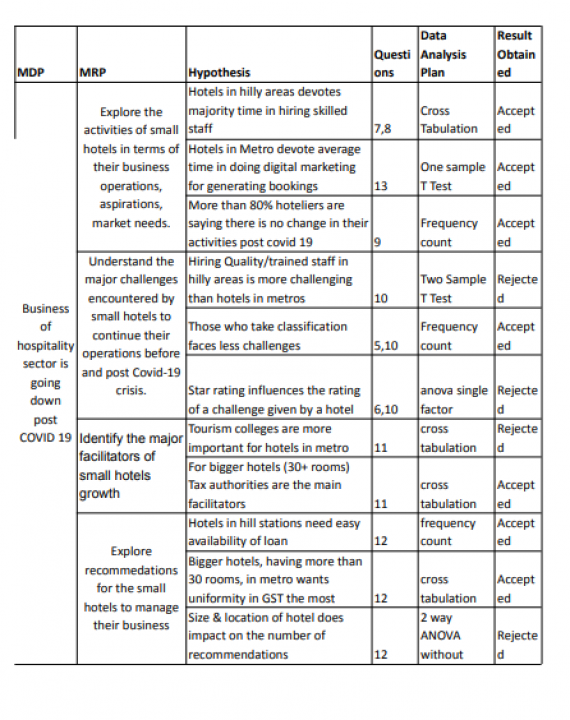
RESEARCH OBJECTIVES, DATAANALYSIS, AND RESULTS
10 Research Objective 1: Explore the activities of small hotels in terms of their business operations, aspirations, market needs. There are many activities which a hotelier does in order to manage his hotel well. From qualitative review it can be easily inferred that hoteliers majorly involved in marketing, human resource and operational activities. Financial activities are also there but that doesn’t take much of their time, as raising working capital is not a regular thing.
Here are some hypotheses which I generated post conducting the qualitative research.
Hypothesis 1: Hotels in hilly areas devote majority time in hiring skilled staff Data Analysis tool: Cross Tabulation

As seen in this cross tabulation table, Hotels in Hill Station devote maximum time in ‘Branding of their hotels’. Therefore, this hypothesis has to be rejected. In fact after looking at this table we can say that hotels in ‘Non Metro City’ devotes maximum time in ‘hiring of labor/staff’
Managerial Implications: Even for hotels in hilly areas branding is a more important activity. Hotel branding includes identity creation like logo, taglines etc; positioning; pricing; promotion in different travel events like SATTE, OTM etc; building B2B networks in order to ensure future sustainability.
Hypothesis 2: Hotels in Metro devote average time in doing digital marketing for generating booking
Ho - Rating of digital marketing by hotels in metro is 3 i.e mu=3 H1 - Rating of digital marketing by hotels in metro is not 3 i.emu!=3 (we will go for two tail test) Data analysis tool: One sample T-Test
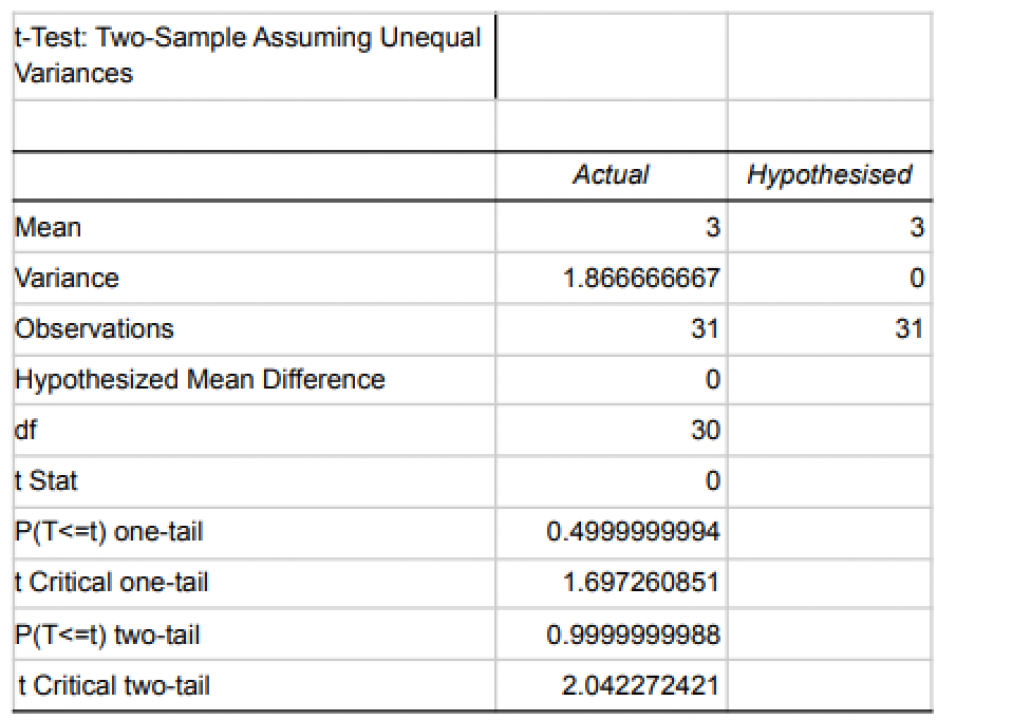
Therefore, at 95% confidence level for the two tail test p-value is = 0.99 which is above alpha value. Hence null hypothesis is accepted.
Managerial Implication: Although digital marketing brings more direct sales for a hotel, owners focus more on branding of hotels by participating in different events and sponsorships. Securing future revenues and long term growth is more important than the short term gains for the hotels in metro areas.
Hypothesis 3: More than 80% hoteliers are saying there is no change in their activities post covid 19 Data analysis tool: frequency count
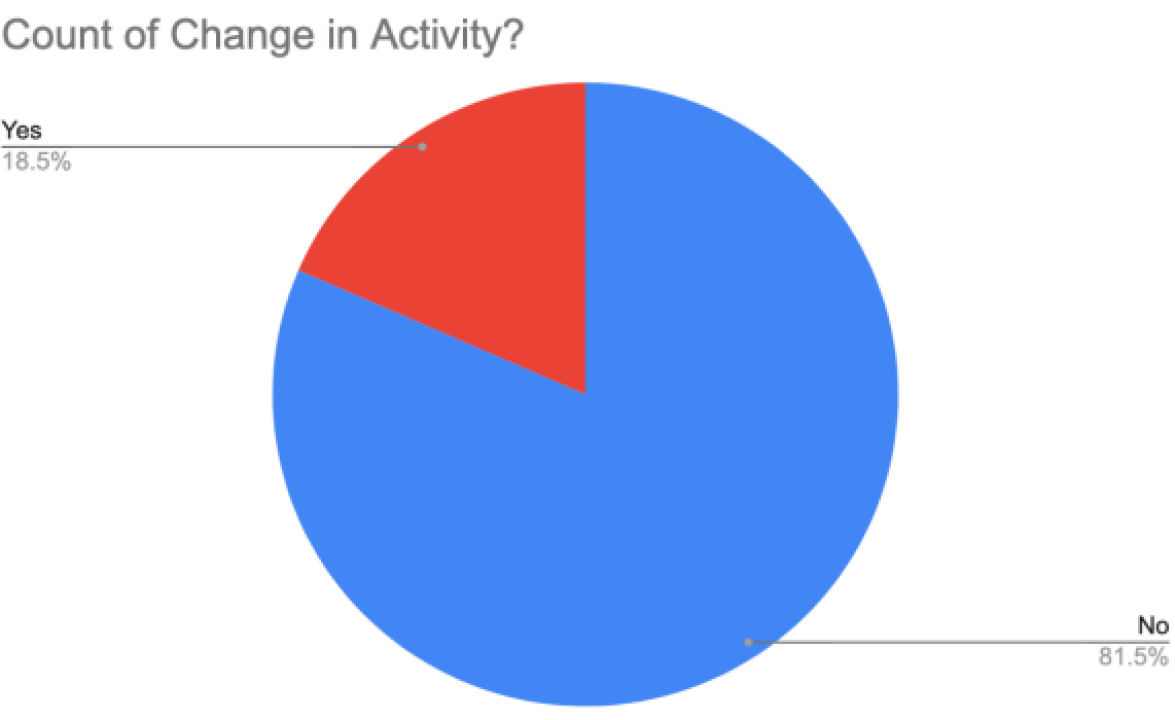
The Null hypothesis is accepted as more than 80% hoteliers are saying that their activities are not different from pre Covid. Managerial Implication: Though the world has changed a lot, hoteliers are still performing the same activities for managing their property.
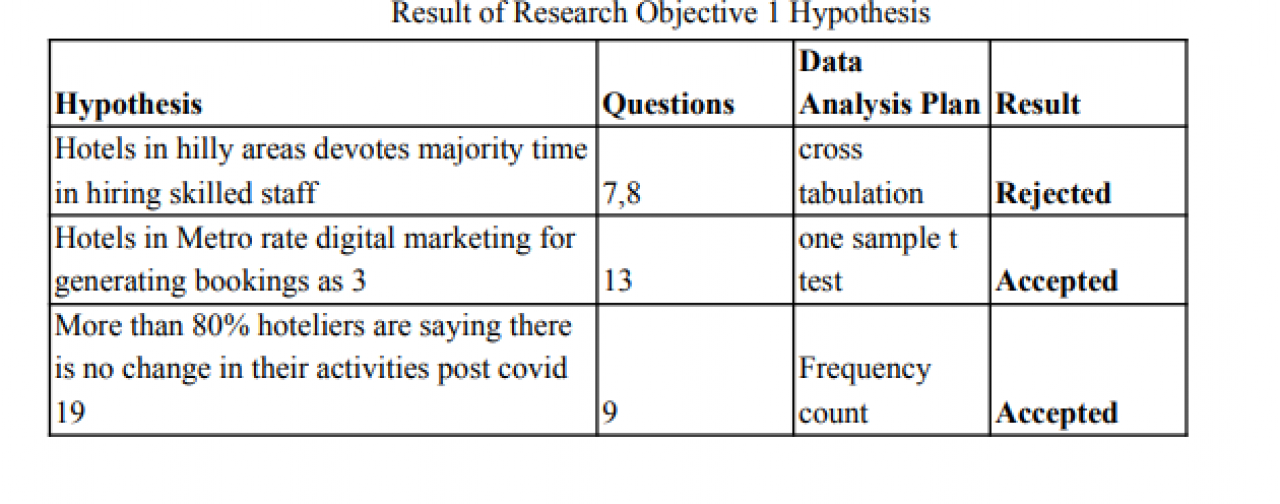
Research Objective 2: Understand the major challenges encountered by small hotels to continue their operations before and post Covid-19 crisis.
Hypothesis 1: Hiring Quality/trained staff in hilly areas is more challenging than hotels in metros 6 out 7 hotels in hill station (Shimla, Manali, Kedarnath, Shillong, Darjeeling, Kashmir) mentioned hiring in their challenge however hotels in metro ie Mr. Qabool, Mr. Ajay didn’t mention hiring in their challenges. Mr Amit Tiwari from Shimla said ‘Quality staff industry ko chod chuka hai, and Shimla main jahaan baraf girti hai and inaccessible ho jata hai sardiyon main - hiring ek bahot bada challenge ban jata hai. Log milte nahi hain and aana bhi nahi chahte’
H0 - mu of hiring in hilly area my of hiring in metro area
H1 - mu of hiring in hilly area > my of hiring in metro area
Data analysis tool: Two sample T Test
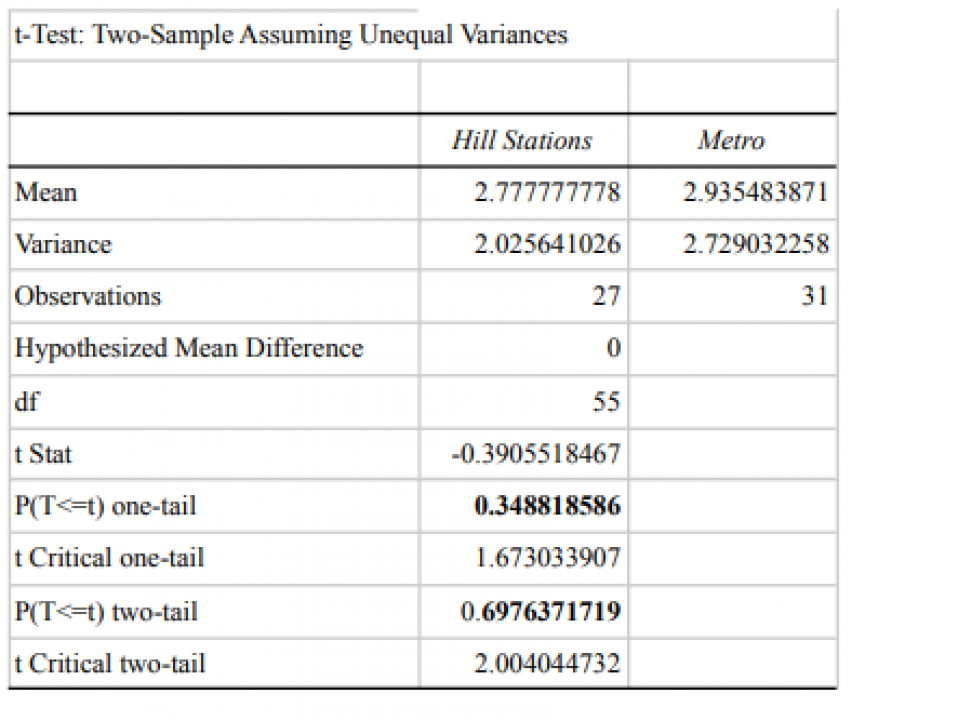
P value i.e 0.34 is more than alpha i.e 0.05 in one tail test. So we cannot say that the hiring challenge rated by hill station hotels is more than that of hiring challenge rated by metro hotels. Hence, we accept the null hypothesis and reject this hypothesis that hill station hotels face more challenges in hiring quality/trained staff.
Managerial Implications: People are ready to go to hill stations for work. There is a lack of staff in the overall hospitality industry.
Hypothesis 2: Those who take classification faces less challenges Data analysis tool: Frequency count

Managerial implications: Taking classification is beneficial and small hotels should strive hard to take it. Poor knowledge and cumbersome process is the reason for not taking classification. The Ministry of Tourism & FHRAI should run a campaign to make hoteliers understand the benefits of taking classifications.
Currently approximately 2000 hotels only have taken the classification out of more than approximately 80000 hotels in India.
Hypothesis 3: Star rating influences the rating of a challenge given by a hotel
Ho - Star rating doesn't have any impact on the rating of a challenge
H1 - Star rating have an impact on the rating of a challenge Data analysis tool: ANOVA Single factor

Since p value is more than alpha, therefore at 95% confidence level we have to accept the null hypothesis and conclude that there is no significant interaction between star rating of a hotel and the rating of the challenges they face.
Managerial implications:
Hospitality industry faces similar challenges irrespective of the star ratings they have taken from the ministry of tourism (MOT). There isn’t much that MOT is contributing to reduce the challenges of operating a hotel in India.
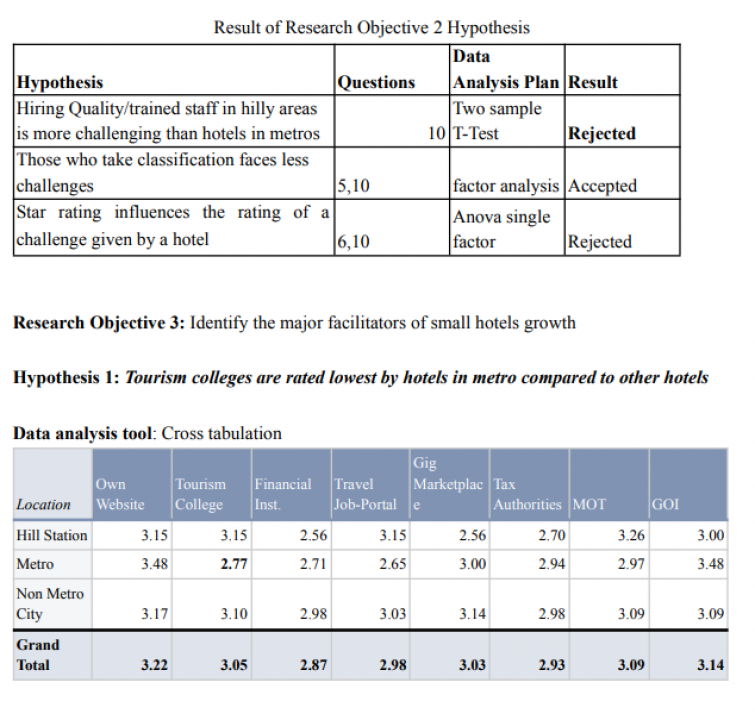
Cross tabulation table shows that hotels in metro rated ‘Tourism College’ the least as compared to other hotels who have rated ‘Tourism College’ comparatively higher. Therefore, this hypothesis is accepted
Managerial Implications: It is easier for hotels in metropolitan areas to find the right talent as our country has talent concentration in metropolitan areas. All major institutions either have main branches in metro areas or satellite campuses.
Hypothesis 2: For bigger hotels (30+ rooms) Tax authorities are the main facilitato
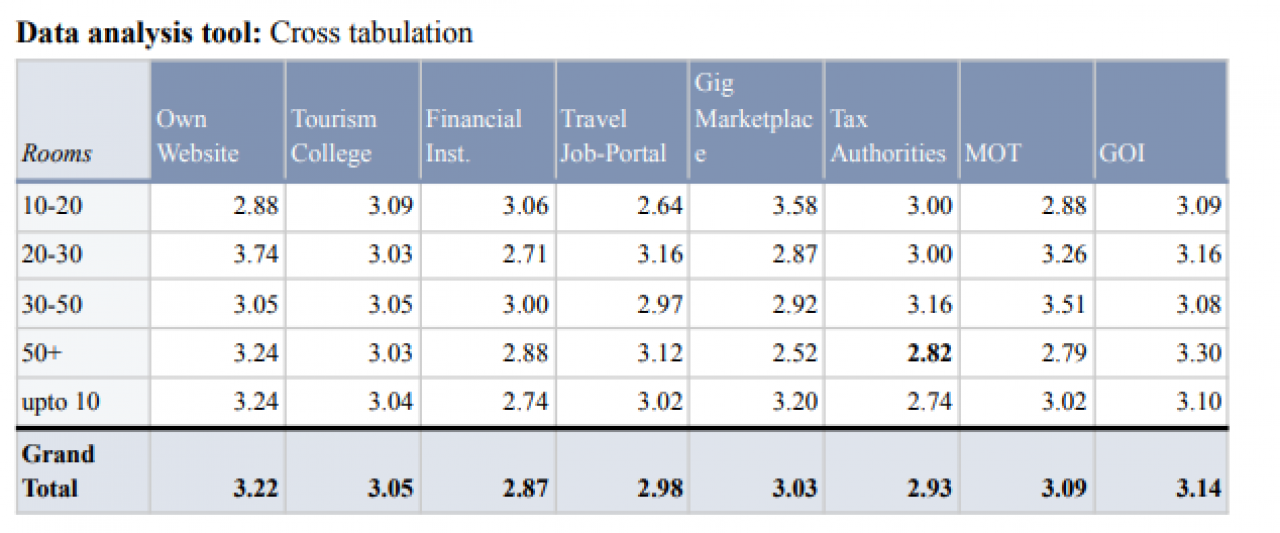
Hotels with rooms more than 50 haven’t rated ‘Tax Authorities’ highest amongst all major facilitators. Therefore this hypothesis shall be rejected.
Managerial Implications: GOI is the main facilitator for bigger hotels & the government should do something about it. Bigger hotels have higher fixed cost and higher taxation. In order to make their business more viable the government should provide some subsidy for e.g should allow hotel reimbursement to government employees who apply for LTA. Currently it is not there.

Research Objective 4: Explore recommendations for the small hotels to manage their business Out of 9 major recommendations, hoteliers have given average 5 recommendations.
Hypothesis 1: Hotels in hill stations need easy availability of loan
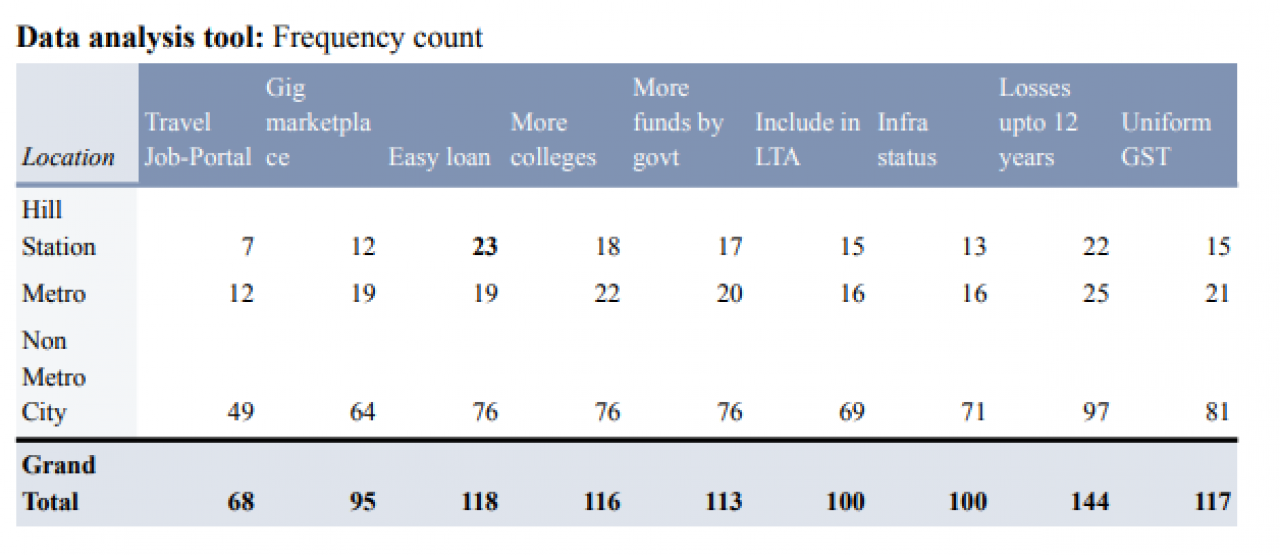
As shown in this cross tabulation table, we can see that hotels in hill stations have the highest frequency count of ‘Easy availability of loan’ i.e 23.
Managerial Implications: Hospitality industry should be whitelisted by financial authorities and there should be more branches of banks in hilly areas as hotels there want easy availability of loans. When loans are not available against the hotel, owners take personal loans in order to meet working capital.
Hypothesis 2: Bigger hotels, having more than 30 rooms, in metro wants uniformity in GST the most
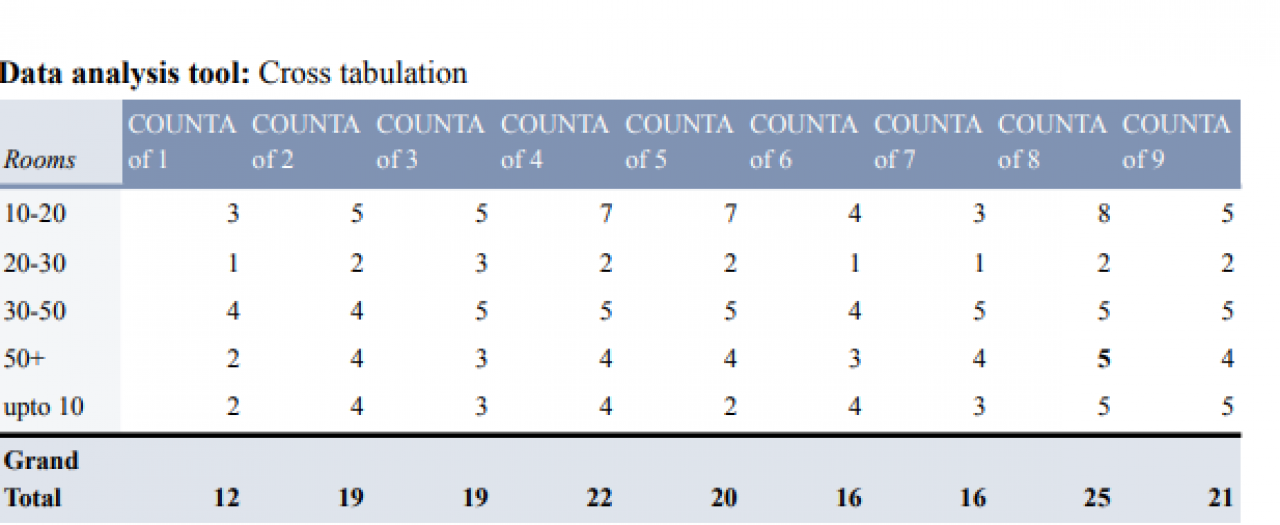
Managerial Implications: Bigger hotels require more initial capital to build and when they are in the metro that cost increases multifolds. That’s why bigger hotels face loss for initial years. They want to set off business losses to upto 12 years which is currently 8 years as per financial norms of our country.
Hypothesis 3: Size & location of hotel impacts the recommendations
Hao - Size of hotel has no significant impact on the number of recommendations
Ha1 - Size of hotel has a significant impact on the number of recommendations
Hb0 - Location of hotel has no significant impact on the number of recommendations
Hb1 - Location of hotel has a significant impact on the number of recommendations
Data analysis tool: Two way Anova without replication
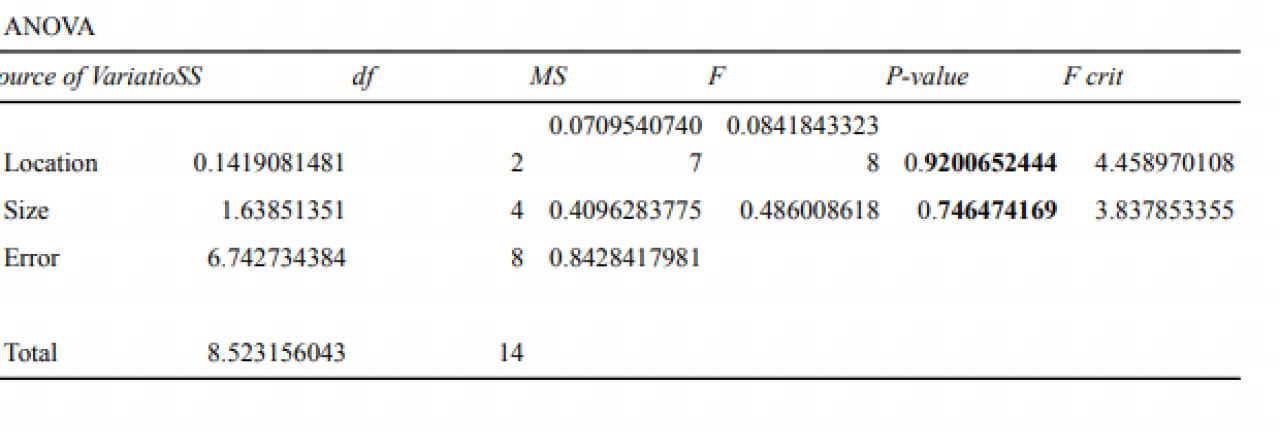
At 95% confidence level we can say that the null hypothesis can’t be rejected. Therefore, size and location doesn’t have a significant impact on the number of recommendations provided by a hotel
Managerial Implication: Hospitality industry overall is impacted in the current business environment and irrespective of size and location, the number of recommendations are not significantly impacted. Average 5 recommendations are provided by each hotel in our quantitative analysis.
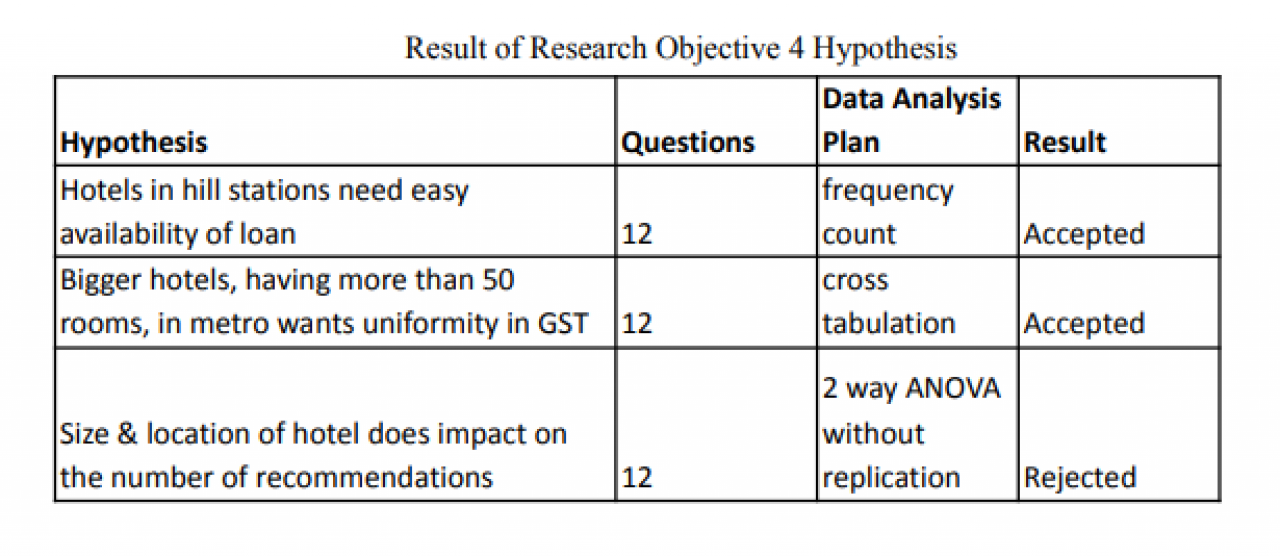
CONCLUSION
At a time when many big hotel groups are gung-ho about the future and are investing heavily in the Indian market and many small hotel owners are shutting their business, it becomes imperative to understand this gap. This study will undertake qualitative and quantitative analysis which will help industry identify the activities & challenges of small hotels who are very important for smooth functioning of top layers too.
When the Ministry of Tourism is creating a database of the hospitality sector (Nidhi 2.0, n.d.) to know the size of the pie, this study shall provide a better understanding of what all is required from policy makers directly from the horse’s mouth.
From the quantitative analysis it can be said that COVID-19 has definitely led to the losses in the hospitality industry however it didn’t impact the way of working. Post covid every hotel has gone back to the same way of working which it used to do prior to COVID-19. Taking star rating classification isn’t mandatory by the ministry of tourism and that’s why many of the hotels don’t go for it. However, taking classification helps! Those who take it face fewer challenges. But classification isn’t sufficient as there is no major difference in the rating of challenges provided by 1 star hotel similar to that of 3 star hotel.
Hiring is the most chosen(n 140 ~76%) activity by all hoteliers which means that the majority of time in the hospitality industry is taken up by hiring activity. This shall be attributed to increase in demand, difficulty in finding the right talent and in lack of availability of trained/qualified staff. Out of many challenges which are faced by hotel owners ‘Don’t have our own IT team’ is the highest rated (avg 3.2) challenge by whole sample, which is then followed by ‘Easy availability of loan’ (avg 3.14). Hospitality industry is frowned upon by financial institutions post COVID-19 due to uncertainty of continuous cash flows. This has made it difficult for hotels to raise investment for scaling & expanding their hotel(s). Hotel industry spends more time in branding than in performance marketing which shows that it is a more future oriented industry which knows long term cash flows are more important than immediate returns. Therefore, it becomes all the more important for the ministry of tourism and government of India to support this industry by providing multiple help for e.g extending the repayment period of ‘Emergency credit line guaranteed scheme (ECLGS)’ loans.
Biggest facilitator for hoteliers is having ‘Own Website - to get direct bookings of customers’ which is rated as 3.22. More than 40% of respondents mentioned that they don’t have a website. All recommendations asked in the questionnaire were given by the hoteliers interviewed. Of all recommendations 9 were primary which were then asked in the questionnaire. And it is found that the maximum number of recommendations were given by those hotels which are in their growth stage i.e having room count of 20-30. Almost 6.8 recommendations were selected by them out of 9. Most selected recommendation by complete sampled hotels is ‘Allow set-off of business losses upto 12 years under Section 72’ because as per financial norm a company cannot set off losses for more than 8 years. Hotel industry is a capital intensive business and a highly competitive industry which makes it tough for hoteliers to recover their losses in 8 years. Therefore, they mostly selected the recommendation of increasing this period to 12 years from 8 years.
LIMITATIONS
1. Respondents who has just started their hotel may not have faced much challenges yet
2. It was observed awareness of govt schemes is not much amongs the hotels in remote locations so they have not marked govt schemes in recommendations. This might have brought some discrepancies in the analysis
3. The limitation of small sample size of hotels in hill stations could be better. Larger sample size would help increase the generalizability of the research findings
References
Abbas, J., Mubeen, R., Iorember, P. T., Raza, S., & Mamirkulova, G. (2021, November). Exploring the impact of COVID-19 on tourism: transformational potential and implications for a sustainable recovery of the travel and leisure industry. Current Research in Behavioral Sciences, 2(100033), 121.
https://www.sciencedirect.com/science/article/pii/S2666518221000206
Choi, S., & Kimes, S. E. (2002, June). Electronic distribution channels' effect on hotel revenue management.
The Cornell Hotel and Restaurant Administration Quarterly, 43(3), 23-31.
0155#! Hotel Industry in India (2018-2023) Overview, Revenue, Growth Forecast, Trends, Drivers, Challenges, and Data on Tourist Arrival, Distribution Channels, Room Tariff, and Key Players (The Lalit, Hyatt Hotels and Resorts, ITC Hotels, Lemon Tree Hotels Limit. (n.d.). MarketResearch.com. Retrieved September 1, 2022, from https://www.marketresearch.com/Netscribes-India-Pvt-Ltd-
3676/Hotel-India-12379982/ Jaipuria, S. (2021, November 29). The impact of COVID-19 on tourism sector in India. Tourism Recreation Research, 46(2), 260.
https://www.tandfonline.com/doi/full/10.1080/02508281.2020.1846971
Kumar, A. (2020). Disastrous impact of Coronavirus (COVID 19) on Tourism and Hospitality Industry in India. Journal of Xi'an University of Architecture & Technology, XII(V), 698-712.
http://xajzkjdx.cn/gallery/69-may2020.pdf Majumdar, R. (2021, October 11). Surviving and growing in the post-Covid world: the case of Indian hotels. Worldwide Hospitality and Tourism Themes, 13(5), 584-598. https://www.emerald.com/insight/content/doi/10.1108/WHATT-05-
2021-0064/full/html Nidhi 2.0. (n.d.). NIDHI+. Retrieved September 1, 2022, from https://nidhi.tourism.gov.in O'Connor, P., & Murphy, J. (2008, November 2). Hotel Yield Management Practices Across Multiple Electronic Distribution Channels. Information Technology & Tourism, 10(2), 161-172(12). https://www.ingentaconnect.com/content/cog/itt/2008/00000010/00000
002/art00006 Parkan, C. (1996, December). Measuring the performance of hotel operations. Socio-Economic Planning Sciences, 30(4), 257-292. https://www.sciencedirect.com/science/article/pii/S0038012196000134
#! Sainagh, R. (2010, October 5). Hotel performance: state of the art. International Journal of Contemporary Hospitality Management, 22(7), 920-952. https://www.emerald.com/insight/content/doi/10.1108/09596111011066617/full/html Singh, A. L., & Jarnal, S. (202, December). Impact assessment of lockdown amid COVID-19 pandemic on tourism industry of Kashmir Valley, India. Research in Globalization, 3(100053), 200.
Tourism and Hospitality Industry, Top Hospitality Industry in India. (n.d.). IBEF. Retrieved September 1, 2022, from https://www.ibef.org/industry/tourism-hospitality-india Wai Lai, I. K. (2020, October 14). Comparing crisis management practices in the hotel industry between initial and pandemic stages of COVID-19. International Journal of Contemporary Hospitality Management, 32(10), 3135-3156. https://www.emerald.com/insight/content/doi/10.1108/IJCHM-04-2020-0325/full/html Zech, N. M. (2016, September 2).
CRISIS MANAGEMENT WITHIN THE HOTEL INDUSTRY – A STAKEHOLDER RELATIONSHIP MANAGEMENT APPROACH. CORE. Retrieved September 1, 2022, from https://core.ac.uk/download/pdf/71807165.pdf Sinha, A. K., & Ekka, P.
(2021). Hospitality industry of india - its present status and future prospects. The Researchers' International Research Journal, 7(1), 85-95. https://theresearchers.asia/Papers/Vol-VII,%20Issue-I-2021/9%20Hospitality%20Industry %20of%20India.pdf Central Government. (1867). Indian Sarais Act 1867. Nic.in. https://thc.nic.in/Central%20Governmental%20Acts/Sarais%20Act,%201867.pdf

Debalina Deb Roy
A seasoned travel writer with a passion for exploring off beat destinations and uncovering the hidden gems. My ultimate goal is to inspire people to step out of their comfort zones and explore the world.
Explore best popularTour Packages
Tripclap connects you with top travel agents
Compare Custom Quotes and get the best package deal
1
Trusted Network Of 8000+ Agents.
2
Book everything together, including stay & transport.
3
Compare agent profiles & verified reviews.
How It Works
Compare Custom Quotes from Top Travel Agents.

Tell us about your trip

Get Custom quotes from top agents.

Choose the package you like
Latest Destinations : -
• Tawang • Jaldhaka • Chiang Rai • Tadoba • Seremban • Karnaprayag • Nandi Hills • Pithoragarh • Mughalsarai • Rasdhoo Island • Doodhpathri • Dhauli • Tehri Garhwal • Bodh • Putrajaya • Junagadh • Shoghi • Santorini • Madrid • Surat Thani • Kargil • Kangra • Kolad • Pula • Surin • Hoa Binh • Chandigarh • Pachmarhi • Addu Atoll • Kurnool • Chamoli • Kolkata • Arki • Solan • Nuh • Thalassery • Bhimbetka • Lakshadweep • Bakkhali • Somnath • Lausanne • Mandu • London • Gopalpur • Genting Highlands • Unakoti • Kurukshetra • Mukutmanipur • Trivandrum • Kanchanaburi
• Tawang • Jaldhaka • Chiang Rai • Tadoba • Seremban • Karnaprayag • Nandi Hills • Pithoragarh • Mughalsarai • Rasdhoo Island • Doodhpathri • Dhauli • Tehri Garhwal • Bodh • Putrajaya • Junagadh • Shoghi • Santorini • Madrid • Surat Thani • Kargil • Kangra • Kolad • Pula • Surin • Hoa Binh • Chandigarh • Pachmarhi • Addu Atoll • Kurnool • Chamoli • Kolkata • Arki • Solan • Nuh • Thalassery • Bhimbetka • Lakshadweep • Bakkhali • Somnath • Lausanne • Mandu • London • Gopalpur • Genting Highlands • Unakoti • Kurukshetra • Mukutmanipur • Trivandrum • Kanchanaburi
Best Selling Domestic Tour Packages : -
Kashmir Tour Packages Andaman Tour Packages Kerala Tour Packages Shimla Tour Packages Manali Tour Packages Sikkim Tour Packages Uttarakhand Tour Packages Rajasthan Tour Packages Chardham Tour Packages Gujarat Tour Packages Rameswaram Tour Packages Gangtok Tour Packages Goa Tour Packages Jaipur Tour Packages Ooty Tour Packages Jim Corbett Tour Packages Mussoorie Tour Packages Kanyakumari Tour Packages Meghalaya Tour Packages Ladakh Tour Packages
Kashmir Tour Packages Andaman Tour Packages Kerala Tour Packages Shimla Tour Packages Manali Tour Packages Sikkim Tour Packages Uttarakhand Tour Packages Rajasthan Tour Packages Chardham Tour Packages Gujarat Tour Packages Rameswaram Tour Packages Gangtok Tour Packages Goa Tour Packages Jaipur Tour Packages Ooty Tour Packages Jim Corbett Tour Packages Mussoorie Tour Packages Kanyakumari Tour Packages Meghalaya Tour Packages Ladakh Tour Packages
Best Selling International Tour Packages : -
Dubai Tour Packages Bali Tour Packages Singapore Tour Packages Thailand Tour Packages Maldives Tour Packages Bhutan Tour Packages Vietnam Tour Packages Mauritius Tour Packages Nepal Tour Packages Europe Tour Packages Sri lanka Tour Packages Turkey Tour Packages Malaysia Tour Packages Azerbaijan Tour Packages
Dubai Tour Packages Bali Tour Packages Singapore Tour Packages Thailand Tour Packages Maldives Tour Packages Bhutan Tour Packages Vietnam Tour Packages Mauritius Tour Packages Nepal Tour Packages Europe Tour Packages Sri lanka Tour Packages Turkey Tour Packages Malaysia Tour Packages Azerbaijan Tour Packages
Certified
We accept (more)
Members of
Media Recognition
Trusted Partners
Award
Copyrights © TripClap. All Rights Reserved
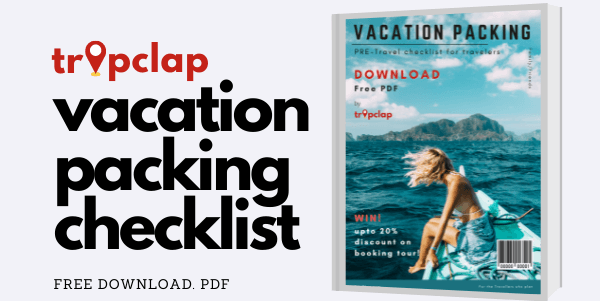

 May
May June
June July
July August
August September
September October
October November
November December
December January
January February
February March
March April
April
